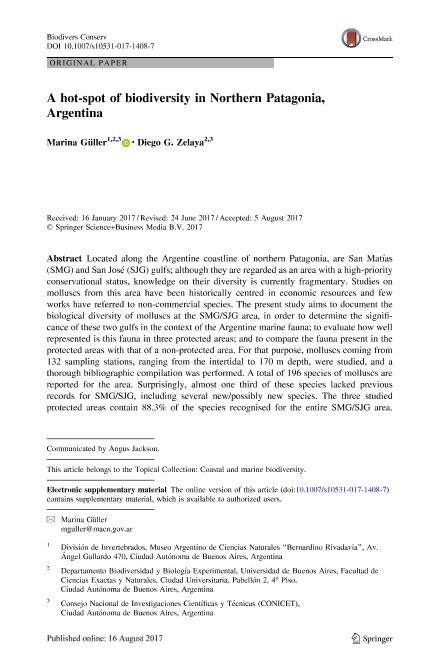Mostrar el registro sencillo del ítem
dc.contributor.author
Güller, Marina

dc.contributor.author
Zelaya, Diego Gabriel

dc.date.available
2018-09-17T22:21:16Z
dc.date.issued
2017-12
dc.identifier.citation
Güller, Marina; Zelaya, Diego Gabriel; A hot-spot of biodiversity in Northern Patagonia, Argentina; Springer; Biodiversity and Conservation; 26; 14; 12-2017; 3329-3342
dc.identifier.issn
0960-3115
dc.identifier.uri
http://hdl.handle.net/11336/60034
dc.description.abstract
Located along the Argentine coastline of northern Patagonia, are San Matías (SMG) and San José (SJG) gulfs; although they are regarded as an area with a high-priority conservational status, knowledge on their diversity is currently fragmentary. Studies on molluscs from this area have been historically centred in economic resources and few works have referred to non-commercial species. The present study aims to document the biological diversity of molluscs at the SMG/SJG area, in order to determine the significance of these two gulfs in the context of the Argentine marine fauna; to evaluate how well represented is this fauna in three protected areas; and to compare the fauna present in the protected areas with that of a non-protected area. For that purpose, molluscs coming from 132 sampling stations, ranging from the intertidal to 170 m depth, were studied, and a thorough bibliographic compilation was performed. A total of 196 species of molluscs are reported for the area. Surprisingly, almost one third of these species lacked previous records for SMG/SJG, including several new/possibly new species. The three studied protected areas contain 88.3% of the species recognised for the entire SMG/SJG area. Although several species appear as exclusive from one of these three areas, many of them are also present in an intermediately located, non-protected area. Molluscan diversity at the SMG/SJG area is greater than previously thought, comprising about 41.4% of the bivalves and 37.8% of the gastropods present in the Argentine shelf; thus suggesting that the area may be considered as a hot-spot of diversity in the Argentine Sea.
dc.format
application/pdf
dc.language.iso
eng
dc.publisher
Springer

dc.rights
info:eu-repo/semantics/openAccess
dc.rights.uri
https://creativecommons.org/licenses/by-nc-sa/2.5/ar/
dc.subject
Coastal Protected Areas
dc.subject
Conservation
dc.subject
Diversity
dc.subject
Inventory
dc.subject
Invertebrates
dc.subject
Mollusca
dc.subject.classification
Otras Ciencias Biológicas

dc.subject.classification
Ciencias Biológicas

dc.subject.classification
CIENCIAS NATURALES Y EXACTAS

dc.title
A hot-spot of biodiversity in Northern Patagonia, Argentina
dc.type
info:eu-repo/semantics/article
dc.type
info:ar-repo/semantics/artículo
dc.type
info:eu-repo/semantics/publishedVersion
dc.date.updated
2018-09-17T19:29:41Z
dc.identifier.eissn
1572-9710
dc.journal.volume
26
dc.journal.number
14
dc.journal.pagination
3329-3342
dc.journal.pais
Alemania

dc.description.fil
Fil: Güller, Marina. Consejo Nacional de Investigaciones Científicas y Técnicas. Oficina de Coordinación Administrativa Parque Centenario. Museo Argentino de Ciencias Naturales “Bernardino Rivadavia”; Argentina
dc.description.fil
Fil: Zelaya, Diego Gabriel. Universidad de Buenos Aires. Facultad de Ciencias Exactas y Naturales. Departamento de Biodiversidad y Biología Experimental; Argentina. Consejo Nacional de Investigaciones Científicas y Técnicas; Argentina
dc.journal.title
Biodiversity and Conservation

dc.relation.alternativeid
info:eu-repo/semantics/altIdentifier/doi/http://dx.doi.org/10.1007/s10531-017-1408-7
dc.relation.alternativeid
info:eu-repo/semantics/altIdentifier/url/https://link.springer.com/article/10.1007%2Fs10531-017-1408-7
Archivos asociados
